Planning. FL lesson The aim of
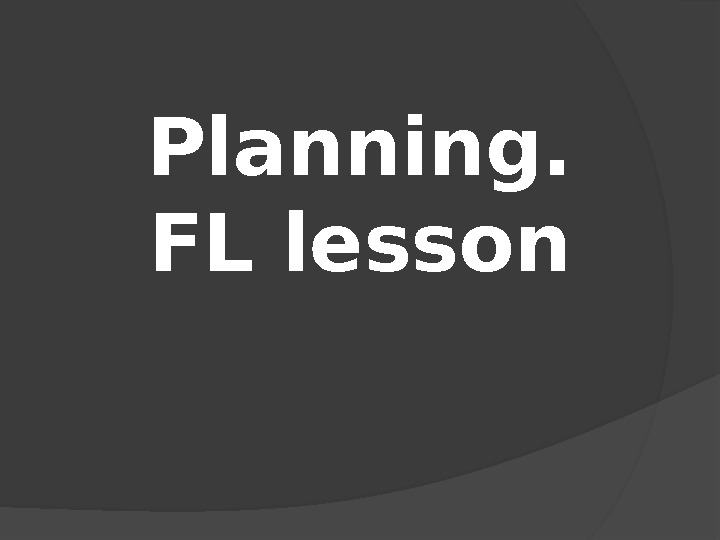
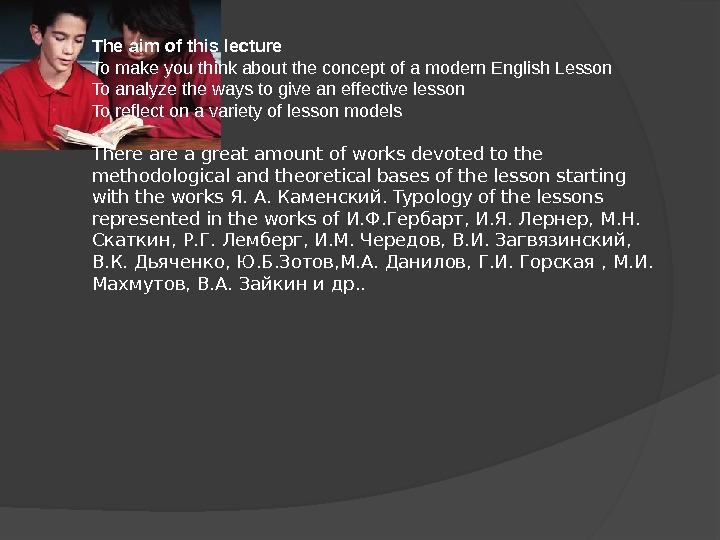

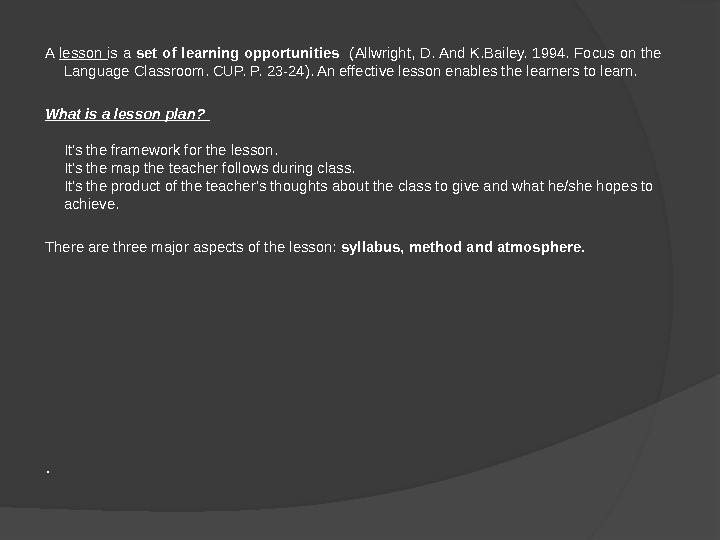
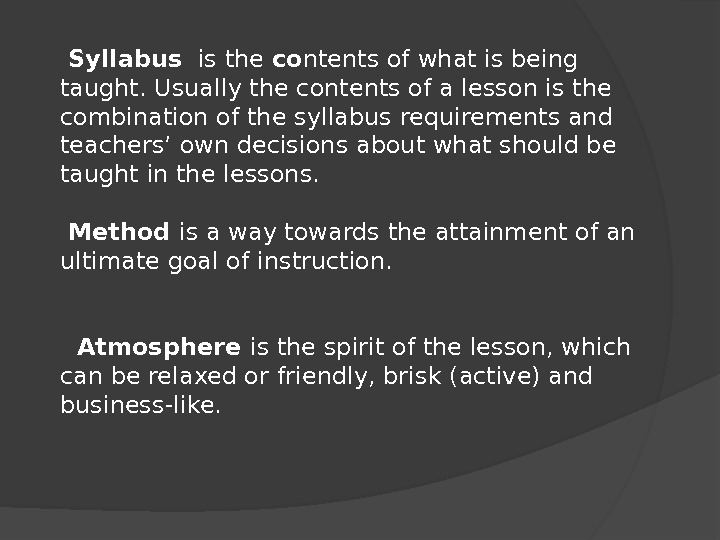
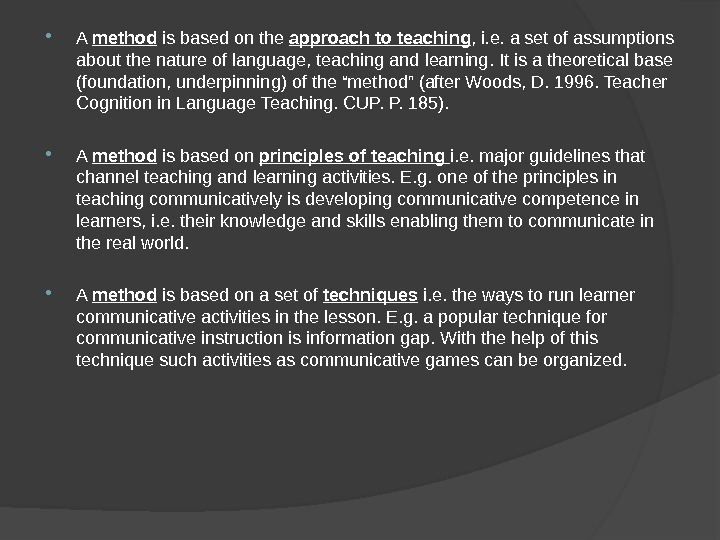

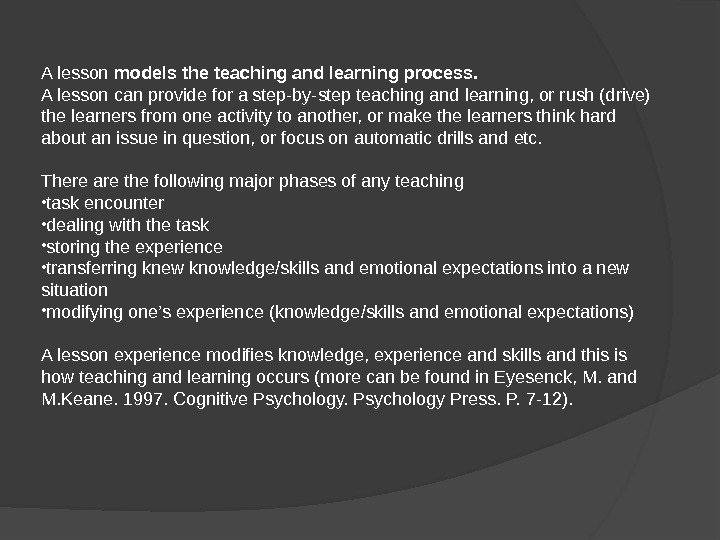

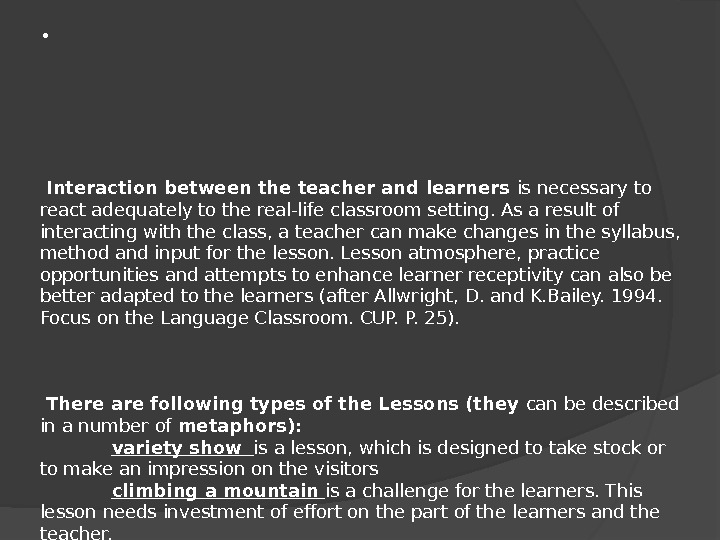
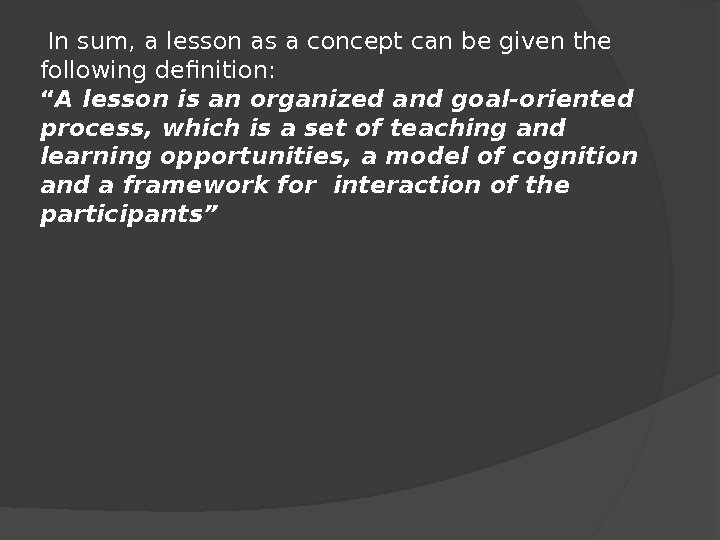
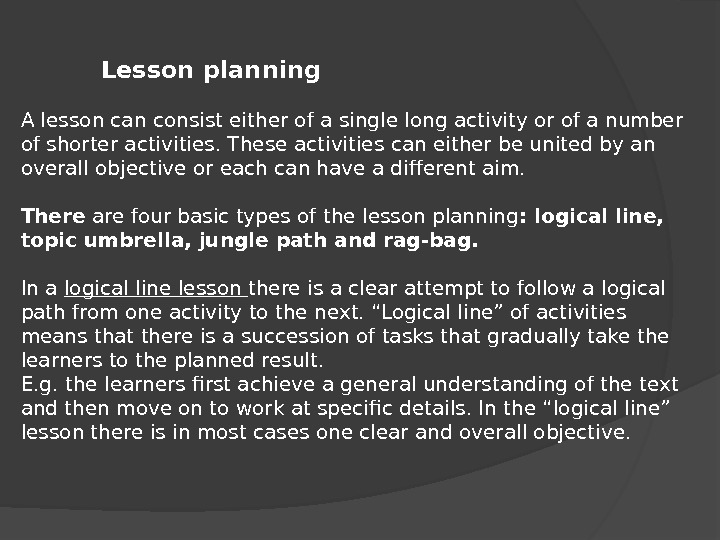
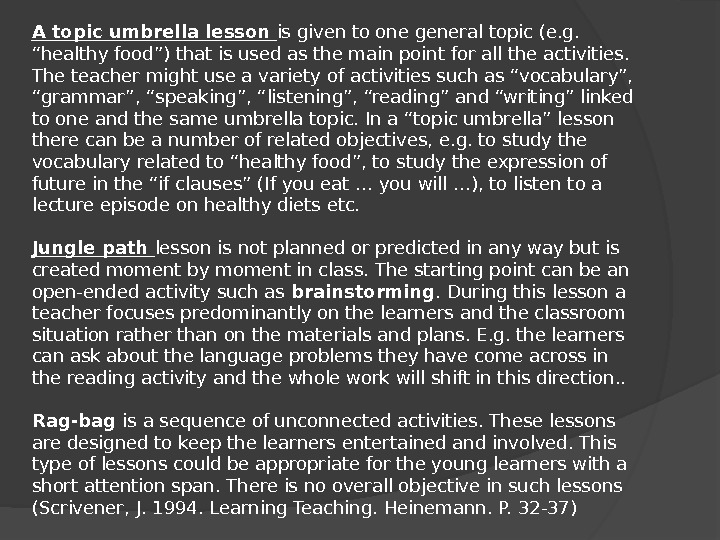
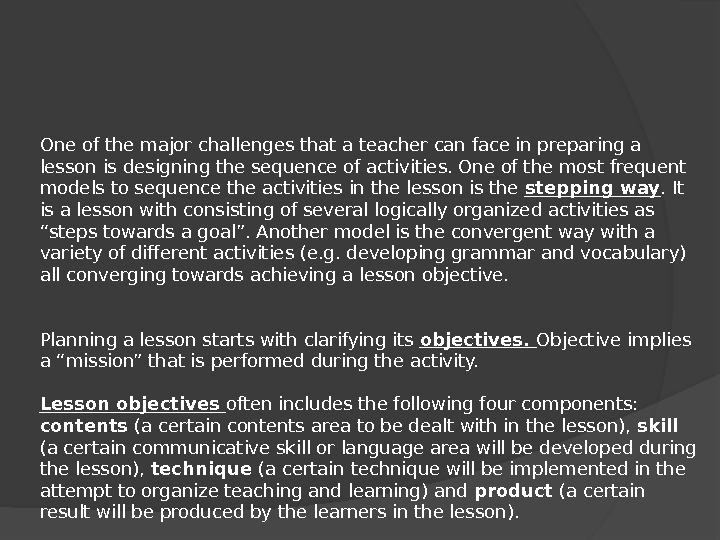
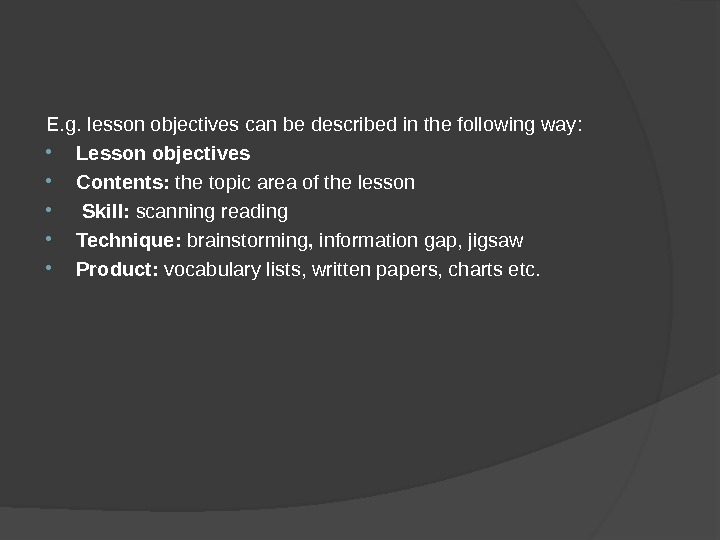

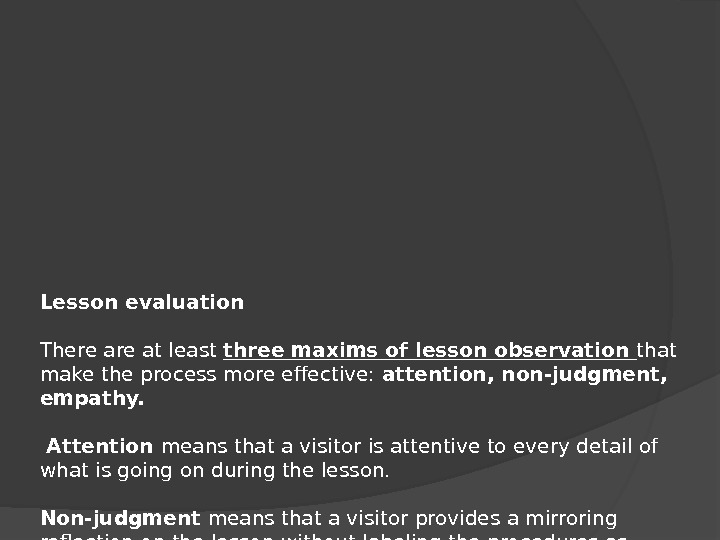
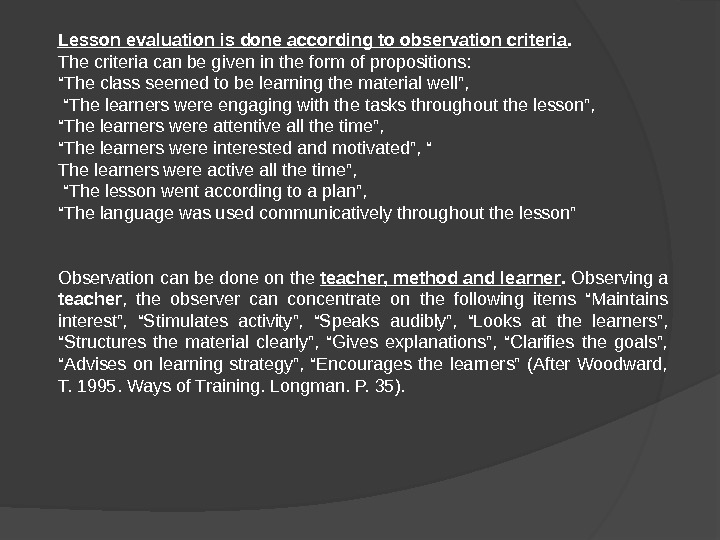

- Размер: 277 Кб
- Количество слайдов: 19
Описание презентации Planning. FL lesson The aim of по слайдам
 Planning. FL lesson
Planning. FL lesson
 The aim of this lecture To make you think about the concept of a modern English Lesson To analyze the ways to give an effective lesson To reflect on a variety of lesson models There a great amount of works devoted to the methodological and theoretical bases of the lesson starting with the works Я. А. Каменский. Typology of the lessons represented in the works of И. Ф. Гербарт , И. Я. Лернер , М. Н. Скаткин , Р. Г. Лемберг , И. М. Чередов , В. И. Загвязинский , В. К. Дьяченко , Ю. Б. Зотов , М. А. Данилов , Г. И. Горская , М. И. Махмутов , В. А. Зайкин и др. .
The aim of this lecture To make you think about the concept of a modern English Lesson To analyze the ways to give an effective lesson To reflect on a variety of lesson models There a great amount of works devoted to the methodological and theoretical bases of the lesson starting with the works Я. А. Каменский. Typology of the lessons represented in the works of И. Ф. Гербарт , И. Я. Лернер , М. Н. Скаткин , Р. Г. Лемберг , И. М. Чередов , В. И. Загвязинский , В. К. Дьяченко , Ю. Б. Зотов , М. А. Данилов , Г. И. Горская , М. И. Махмутов , В. А. Зайкин и др. .
 Why planning? Planning helps you to reduce uncertainty and gives you confidence and clarity. It reminds you to prepare materials beforehand, and makes it easier for you to organize the time and activities flow in classes. Why planning? For students, evidence of a plan shows them the teacher has devoted time to thinking about the class. It is a way to help gain the respect of your students. It suggests professionalism and commitment.
Why planning? Planning helps you to reduce uncertainty and gives you confidence and clarity. It reminds you to prepare materials beforehand, and makes it easier for you to organize the time and activities flow in classes. Why planning? For students, evidence of a plan shows them the teacher has devoted time to thinking about the class. It is a way to help gain the respect of your students. It suggests professionalism and commitment.
 A lesson is a set of learning opportunities (Allwright, D. And K. Bailey. 1994. Focus on the Language Classroom. CUP. P. 23 -24). An effective lesson enables the learners to learn. What is a lesson plan? It’s the framework for the lesson. It’s the map the teacher follows during class. It’s the product of the teacher’s thoughts about the class to give and what he/she hopes to achieve. There are three major aspects of the lesson: syllabus, method and atmosphere. .
A lesson is a set of learning opportunities (Allwright, D. And K. Bailey. 1994. Focus on the Language Classroom. CUP. P. 23 -24). An effective lesson enables the learners to learn. What is a lesson plan? It’s the framework for the lesson. It’s the map the teacher follows during class. It’s the product of the teacher’s thoughts about the class to give and what he/she hopes to achieve. There are three major aspects of the lesson: syllabus, method and atmosphere. .
 Syllabus is the co ntents of what is being taught. Usually the contents of a lesson is the combination of the syllabus requirements and teachers’ own decisions about what should be taught in the lessons. Method is a way towards the attainment of an ultimate goal of instruction. Atmosphere is the spirit of the lesson, which can be relaxed or friendly, brisk (active) and business-like.
Syllabus is the co ntents of what is being taught. Usually the contents of a lesson is the combination of the syllabus requirements and teachers’ own decisions about what should be taught in the lessons. Method is a way towards the attainment of an ultimate goal of instruction. Atmosphere is the spirit of the lesson, which can be relaxed or friendly, brisk (active) and business-like.
 A method is based on the approach to teaching , i. e. a set of assumptions about the nature of language, teaching and learning. It is a theoretical base (foundation, underpinning) of the “method” (after Woods, D. 1996. Teacher Cognition in Language Teaching. CUP. P. 185). A method is based on principles of teaching i. e. major guidelines that channel teaching and learning activities. E. g. one of the principles in teaching communicatively is developing communicative competence in learners, i. e. their knowledge and skills enabling them to communicate in the real world. A method is based on a set of techniques i. e. the ways to run learner communicative activities in the lesson. E. g. a popular technique for communicative instruction is information gap. With the help of this technique such activities as communicative games can be organized.
A method is based on the approach to teaching , i. e. a set of assumptions about the nature of language, teaching and learning. It is a theoretical base (foundation, underpinning) of the “method” (after Woods, D. 1996. Teacher Cognition in Language Teaching. CUP. P. 185). A method is based on principles of teaching i. e. major guidelines that channel teaching and learning activities. E. g. one of the principles in teaching communicatively is developing communicative competence in learners, i. e. their knowledge and skills enabling them to communicate in the real world. A method is based on a set of techniques i. e. the ways to run learner communicative activities in the lesson. E. g. a popular technique for communicative instruction is information gap. With the help of this technique such activities as communicative games can be organized.
 Method implementation depends much on teachers’ beliefs, views and knowledge. Teachers’ beliefs, views and knowledge play an important (crucial) role in highlighting part of the syllabus, choosing a method of teaching and creating a certain atmosphere in the lesson. The three aspects of the lesson (syllabus, method and atmosphere) produce three major lesson opportunities : input opportunity, practice opportunity for learner receptivity (high self-esteem, motivation, involvement, confidence and success-building)
Method implementation depends much on teachers’ beliefs, views and knowledge. Teachers’ beliefs, views and knowledge play an important (crucial) role in highlighting part of the syllabus, choosing a method of teaching and creating a certain atmosphere in the lesson. The three aspects of the lesson (syllabus, method and atmosphere) produce three major lesson opportunities : input opportunity, practice opportunity for learner receptivity (high self-esteem, motivation, involvement, confidence and success-building)
 A lesson models the teaching and learning process. A lesson can provide for a step-by-step teaching and learning, or rush (drive) the learners from one activity to another, or make the learners think hard about an issue in question, or focus on automatic drills and etc. There are the following major phases of any teaching • task encounter • dealing with the task • storing the experience • transferring knew knowledge/skills and emotional expectations into a new situation • modifying one’s experience (knowledge/skills and emotional expectations) A lesson experience modifies knowledge, experience and skills and this is how teaching and learning occurs (more can be found in Eyesenck, M. and M. Keane. 1997. Cognitive Psychology Press. P. 7 -12).
A lesson models the teaching and learning process. A lesson can provide for a step-by-step teaching and learning, or rush (drive) the learners from one activity to another, or make the learners think hard about an issue in question, or focus on automatic drills and etc. There are the following major phases of any teaching • task encounter • dealing with the task • storing the experience • transferring knew knowledge/skills and emotional expectations into a new situation • modifying one’s experience (knowledge/skills and emotional expectations) A lesson experience modifies knowledge, experience and skills and this is how teaching and learning occurs (more can be found in Eyesenck, M. and M. Keane. 1997. Cognitive Psychology Press. P. 7 -12).
 A lesson is an arena of learners interaction. The learners interact to combine the knowledge between themselves and to co-operate in producing ideas. They exchange and share knowledge between themselves. They can also mutually control each other and correct errors, as well as to coach each other for specific tasks and tests. For the purpose of interaction, the learners form pairs or small co-operative groups. First the learners may fail to co-operate effectively but gradually they learn how to perform effectively in pairs and small groups (Wright, T. 1987 The Role of Teachers and Learners. ).
A lesson is an arena of learners interaction. The learners interact to combine the knowledge between themselves and to co-operate in producing ideas. They exchange and share knowledge between themselves. They can also mutually control each other and correct errors, as well as to coach each other for specific tasks and tests. For the purpose of interaction, the learners form pairs or small co-operative groups. First the learners may fail to co-operate effectively but gradually they learn how to perform effectively in pairs and small groups (Wright, T. 1987 The Role of Teachers and Learners. ).
 • Interaction between the teacher and learners is necessary to react adequately to the real-life classroom setting. As a result of interacting with the class, a teacher can make changes in the syllabus, method and input for the lesson. Lesson atmosphere, practice opportunities and attempts to enhance learner receptivity can also be better adapted to the learners (after Allwright, D. and K. Bailey. 1994. Focus on the Language Classroom. CUP. P. 25). There are following types of the Lessons (they can be described in a number of metaphors): variety show is a lesson, which is designed to take stock or to make an impression on the visitors climbing a mountain is a challenge for the learners. This lesson needs investment of effort on the part of the learners and the teacher. eating a meal is an essentially receptive and drilling lesson focused on receiving and reinforcing the input (After Ur, P. 1996. A Course in English Language Teaching. CUP. P. 223 -224).
• Interaction between the teacher and learners is necessary to react adequately to the real-life classroom setting. As a result of interacting with the class, a teacher can make changes in the syllabus, method and input for the lesson. Lesson atmosphere, practice opportunities and attempts to enhance learner receptivity can also be better adapted to the learners (after Allwright, D. and K. Bailey. 1994. Focus on the Language Classroom. CUP. P. 25). There are following types of the Lessons (they can be described in a number of metaphors): variety show is a lesson, which is designed to take stock or to make an impression on the visitors climbing a mountain is a challenge for the learners. This lesson needs investment of effort on the part of the learners and the teacher. eating a meal is an essentially receptive and drilling lesson focused on receiving and reinforcing the input (After Ur, P. 1996. A Course in English Language Teaching. CUP. P. 223 -224).
 In sum, a lesson as a concept can be given the following definition: “ A lesson is an organized and goal-oriented process, which is a set of teaching and learning opportunities, a model of cognition and a framework for interaction of the participants”
In sum, a lesson as a concept can be given the following definition: “ A lesson is an organized and goal-oriented process, which is a set of teaching and learning opportunities, a model of cognition and a framework for interaction of the participants”
 Lesson planning A lesson can consist either of a single long activity or of a number of shorter activities. These activities can either be united by an overall objective or each can have a different aim. There are four basic types of the lesson planning : logical line, topic umbrella, jungle path and rag-bag. In a logical line lesson there is a clear attempt to follow a logical path from one activity to the next. “Logical line” of activities means that there is a succession of tasks that gradually take the learners to the planned result. E. g. the learners first achieve a general understanding of the text and then move on to work at specific details. In the “logical line” lesson there is in most cases one clear and overall objective.
Lesson planning A lesson can consist either of a single long activity or of a number of shorter activities. These activities can either be united by an overall objective or each can have a different aim. There are four basic types of the lesson planning : logical line, topic umbrella, jungle path and rag-bag. In a logical line lesson there is a clear attempt to follow a logical path from one activity to the next. “Logical line” of activities means that there is a succession of tasks that gradually take the learners to the planned result. E. g. the learners first achieve a general understanding of the text and then move on to work at specific details. In the “logical line” lesson there is in most cases one clear and overall objective.
 A topic umbrella lesson is given to one general topic (e. g. “healthy food”) that is used as the main point for all the activities. The teacher might use a variety of activities such as “vocabulary”, “grammar”, “speaking”, “listening”, “reading” and “writing” linked to one and the same umbrella topic. In a “topic umbrella” lesson there can be a number of related objectives, e. g. to study the vocabulary related to “healthy food”, to study the expression of future in the “if clauses” (If you eat … you will …), to listen to a lecture episode on healthy diets etc. Jungle path lesson is not planned or predicted in any way but is created moment by moment in class. The starting point can be an open-ended activity such as brainstorming. During this lesson a teacher focuses predominantly on the learners and the classroom situation rather than on the materials and plans. E. g. the learners can ask about the language problems they have come across in the reading activity and the whole work will shift in this direction. . Rag-bag is a sequence of unconnected activities. These lessons are designed to keep the learners entertained and involved. This type of lessons could be appropriate for the young learners with a short attention span. There is no overall objective in such lessons (Scrivener, J. 1994. Learning Teaching. Heinemann. P. 32 -37)
A topic umbrella lesson is given to one general topic (e. g. “healthy food”) that is used as the main point for all the activities. The teacher might use a variety of activities such as “vocabulary”, “grammar”, “speaking”, “listening”, “reading” and “writing” linked to one and the same umbrella topic. In a “topic umbrella” lesson there can be a number of related objectives, e. g. to study the vocabulary related to “healthy food”, to study the expression of future in the “if clauses” (If you eat … you will …), to listen to a lecture episode on healthy diets etc. Jungle path lesson is not planned or predicted in any way but is created moment by moment in class. The starting point can be an open-ended activity such as brainstorming. During this lesson a teacher focuses predominantly on the learners and the classroom situation rather than on the materials and plans. E. g. the learners can ask about the language problems they have come across in the reading activity and the whole work will shift in this direction. . Rag-bag is a sequence of unconnected activities. These lessons are designed to keep the learners entertained and involved. This type of lessons could be appropriate for the young learners with a short attention span. There is no overall objective in such lessons (Scrivener, J. 1994. Learning Teaching. Heinemann. P. 32 -37)
 One of the major challenges that a teacher can face in preparing a lesson is designing the sequence of activities. One of the most frequent models to sequence the activities in the lesson is the stepping way. It is a lesson with consisting of several logically organized activities as “steps towards a goal”. Another model is the convergent way with a variety of different activities (e. g. developing grammar and vocabulary) all converging towards achieving a lesson objective. Planning a lesson starts with clarifying its objectives. Objective implies a “mission” that is performed during the activity. Lesson objectives often includes the following four components: contents (a certain contents area to be dealt with in the lesson), skill (a certain communicative skill or language area will be developed during the lesson), technique (a certain technique will be implemented in the attempt to organize teaching and learning) and product (a certain result will be produced by the learners in the lesson).
One of the major challenges that a teacher can face in preparing a lesson is designing the sequence of activities. One of the most frequent models to sequence the activities in the lesson is the stepping way. It is a lesson with consisting of several logically organized activities as “steps towards a goal”. Another model is the convergent way with a variety of different activities (e. g. developing grammar and vocabulary) all converging towards achieving a lesson objective. Planning a lesson starts with clarifying its objectives. Objective implies a “mission” that is performed during the activity. Lesson objectives often includes the following four components: contents (a certain contents area to be dealt with in the lesson), skill (a certain communicative skill or language area will be developed during the lesson), technique (a certain technique will be implemented in the attempt to organize teaching and learning) and product (a certain result will be produced by the learners in the lesson).
 E. g. lesson objectives can be described in the following way: Lesson objectives Contents: the topic area of the lesson Skill: scanning reading Technique: brainstorming , information gap, jigsaw Product: vocabulary lists, written papers, charts etc.
E. g. lesson objectives can be described in the following way: Lesson objectives Contents: the topic area of the lesson Skill: scanning reading Technique: brainstorming , information gap, jigsaw Product: vocabulary lists, written papers, charts etc.
 Giving a lesson involves classroom management. It involves the following elements: Starting a lesson Using classroom board in a well organized way Maintaining discipline in the classroom Arranging seats adequately to the tasks Confidence building in learners Timing a lesson Giving directions to the learners Rationing teacher talking time Rationing learner time on task Closing up
Giving a lesson involves classroom management. It involves the following elements: Starting a lesson Using classroom board in a well organized way Maintaining discipline in the classroom Arranging seats adequately to the tasks Confidence building in learners Timing a lesson Giving directions to the learners Rationing teacher talking time Rationing learner time on task Closing up
 Lesson evaluation There at least three maxims of lesson observation that make the process more effective: attention, non-judgment, empathy. Attention means that a visitor is attentive to every detail of what is going on during the lesson. Non-judgment means that a visitor provides a mirroring reflection on the lesson without labeling the procedures as either “good” or “bad”. Empathy implies that a visitor is prepared to understand all the “ co ral reefs” of the lesson and to side fully with the teacher whose lesson is being observed.
Lesson evaluation There at least three maxims of lesson observation that make the process more effective: attention, non-judgment, empathy. Attention means that a visitor is attentive to every detail of what is going on during the lesson. Non-judgment means that a visitor provides a mirroring reflection on the lesson without labeling the procedures as either “good” or “bad”. Empathy implies that a visitor is prepared to understand all the “ co ral reefs” of the lesson and to side fully with the teacher whose lesson is being observed.
 Lesson evaluation is done according to observation criteria. The criteria can be given in the form of propositions: “ The class seemed to be learning the material well”, “ The learners were engaging with the tasks throughout the lesson”, “ The learners were attentive all the time”, “ The learners were interested and motivated”, “ The learners were active all the time”, “ The lesson went according to a plan”, “ The language was used communicatively throughout the lesson” Observation can be done on the teacher, method and learner. Observing a teacher , the observer can concentrate on the following items “Maintains interest”, “Stimulates activity”, “Speaks audibly”, “Looks at the learners”, “Structures the material clearly”, “Gives explanations”, “Clarifies the goals”, “Advises on learning strategy”, “Encourages the learners” (After Woodward, T. 1995. Ways of Training. Longman. P. 35).
Lesson evaluation is done according to observation criteria. The criteria can be given in the form of propositions: “ The class seemed to be learning the material well”, “ The learners were engaging with the tasks throughout the lesson”, “ The learners were attentive all the time”, “ The learners were interested and motivated”, “ The learners were active all the time”, “ The lesson went according to a plan”, “ The language was used communicatively throughout the lesson” Observation can be done on the teacher, method and learner. Observing a teacher , the observer can concentrate on the following items “Maintains interest”, “Stimulates activity”, “Speaks audibly”, “Looks at the learners”, “Structures the material clearly”, “Gives explanations”, “Clarifies the goals”, “Advises on learning strategy”, “Encourages the learners” (After Woodward, T. 1995. Ways of Training. Longman. P. 35).
 In observing the method of instruction the framework of observation will be different. The observers can concentrate on “Communicative activities”, “Interactive activities”, “Challenging activities”, “Comprehensible material”, “Motivating material”, “Logical sequence of activities”, “Developing communicative skills”, “Developing language competence”, “Reinforcing the knowledge”. In observing the learner the observation format changes and can include the following: “ Understand the task”, “Familiar with the task format” (obviously have experience in performing similar tasks), “ Have a good command of previously learned knowledge”, “ Give a prompt response to the teacher”, “Co-operate with each other”, “Attentive”, “Involved in the lesson procedures”.
In observing the method of instruction the framework of observation will be different. The observers can concentrate on “Communicative activities”, “Interactive activities”, “Challenging activities”, “Comprehensible material”, “Motivating material”, “Logical sequence of activities”, “Developing communicative skills”, “Developing language competence”, “Reinforcing the knowledge”. In observing the learner the observation format changes and can include the following: “ Understand the task”, “Familiar with the task format” (obviously have experience in performing similar tasks), “ Have a good command of previously learned knowledge”, “ Give a prompt response to the teacher”, “Co-operate with each other”, “Attentive”, “Involved in the lesson procedures”.
